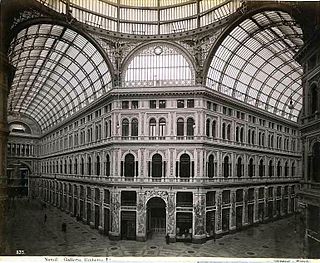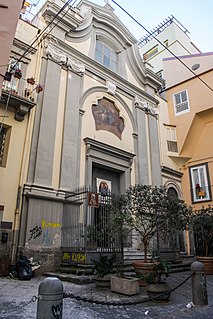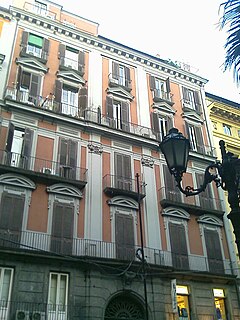
Tommaso Maria Napoli was an Italian architect, Dominican Order monk, engineer and mathematician.

Galleria Umberto I is a public shopping gallery in Naples, southern Italy. It is located directly across from the San Carlo opera house. It was built between 1887–1891, and was the cornerstone in the decades-long rebuilding of Naples — called the risanamento — that lasted until World War I. It was designed by Emanuele Rocco, who employed modern architectural elements reminiscent of the Galleria Vittorio Emanuele II in Milan. The Galleria was named for Umberto I, King of Italy at the time of construction. It was meant to combine businesses, shops, cafes and social life — public space — with private space in the apartments on the third floor.

University of Naples "L'Orientale", is a university located in Naples, Italy. It was founded in 1732 and is organized in 4 Faculties. It is the oldest school of Sinology and Oriental Studies of the European continent and the main university in Italy specialized in the study of non-European languages and cultures, with research and studies agreements with universities from all over the world. It is one of the most prestigious universities in the world regarding Asian cultures and languages.
Cappella Neapolitana is an early music ensemble based in Naples and dedicated to the recovery of Neapolitan musical heritage, primarily from the baroque era.

San Carlo all'Arena is a Roman Catholic church built in a Baroque-style layout with a Neoclassic façade, and located on via Foria in the quartiere or neighborhood of the San Carlo all'Arena, in the city of Naples, Italy.

Santa Maria dell’Aiuto or Holy Mary of Succour is a Baroque-style church, located at Vico S Maria dell'Aiuto number 10, near the church of Santa Maria la Nova in Naples, Italy

The Bourbon Tunnel, Tunnel Borbonico or Bourbon Gallery is an ancient underground passage, constructed for military purposes to connect the Royal Palace to military barracks in Naples, Italy.

The Palazzo delle Poste is located in Piazza Matteotti in central Naples. It is an example of architecture completed during the fascist government of Benito Mussolini. Another such example is the nearby Palazzo della Casa del Mutilato and the adjacent Palazzo della Questura on via Medina. Just north and across the street on via Monteoliveto is the 16th-century Palazzo Orsini di Gravina.
The Palazzo della Casa del Mutilato is a building, located on via Guantai Nuovi and via Diaz, in piazza Matteotti in Naples, Italy. It is an example of the Fascist architecture constructed during the rule of Benito Mussolini, just like the large convex-facade of the central post office building across the street.

Palazzo Barbaja is a palace located on via Toledo of the quartiere San Ferdinando of Naples, Italy.

The Palace of the Bank of Italy is a twentieth century monumental building in central Naples, Italy located in Via Cervantes.

The Palazzo Orsini di Gravina is a Renaissance-style palace on number 3 Via Monteoliveto, in the San Lorenzo quarter of Rione San Giuseppe-Carità, of central Naples, Italy. Since 1940, it has housed the Faculty of Architecture of the University of Naples. It is located across the street and a few doors north of the sleek and modern Palazzo delle Poste. Across the street at the north end of the palace, is the Piazza Monteoliveto with its Fountain and the church of Sant'Anna dei Lombardi.

The Palazzo Giordano in central Naples, Italy, is a Palace located on via Medina 61 in the Quartiere San Giuseppe of Rione Carita. It is flanked by the contemporary Palazzo d'Aquino di Caramanico to the tall modern NH Ambassador Hotel, two doors down from the also modern Palazzo della Questura, and diagonally across the street from the church of San Diego all'Ospedalletto. The palace has had many owners, and variously called Palazzo Carafa di Noja and Palazzo Caracciolo di Forino.

The Palazzo d'Aquino di Caramanico in central Naples, Italy, is a Palace located on via Medina in the Quartiere San Giuseppe of Rione Carita. It is flanked by the contemporary Palazzo Giordano and two doors down from the tall modern NH Ambassador Hotel.

The Palazzo Cellamare or Cellammare is a monumental palace located in via Chiaia 139 in the Quartiere San Ferdinando of Naples, Italy. The entrance is near the church of Santa Caterina a Chiaia.
The Palazzo Ricca is a monumental palace, located on the southernmost end of Via dei Tribunali #231, in central Naples, region of Campania, Italy. It presently houses the archives of the Foundation of the Istituto Banco di Napoli. The palace is just down the street from the entrance to Castel Capuano

The Poggio Reale villa or Villa Poggio Reale was an Italian Renaissance villa commissioned in 1487 by Alfonso II of Naples as a royal summer residence. The Italian phrase "poggio reale" translates to "royal hill" in English. The villa was designed and built by Giuliano da Maiano and located in the city of Naples, in the district now known as Poggioreale, between the present Via del Campo, Via Santa Maria del Pianto and the new and old Via Poggioreale. At the time it was built, a period when the capitol city of the Kingdom of Naples was renowned for elegant homes with expansive vistas of the surrounding landscape and Mount Vesuvius, the villa was outside the city walls of Naples and was one of the most important architectural achievements of the Neapolitan Renaissance. Imitated, admired, robbed of its treasures by another king, left in ruins and partially destroyed, the summer palace of the King of Naples lives on in name as a style.

Santi Demetrio e Bonifacio is a former-Roman Catholic church located on Piazzetta Teodoro Monticelli, in central Naples, Italy. It is now used for meetings and exhibitions by the Department of Architecture of the University of Naples.

The Palazzo di Sangro di Casacalenda is an 18th-century aristocratic palace located across a pizza from the church of San Domenico Maggiore in central Naples, region of Campania, Italy. The East flank of the facade faces the facade of the church of Sant'Angelo a Nilo.




















